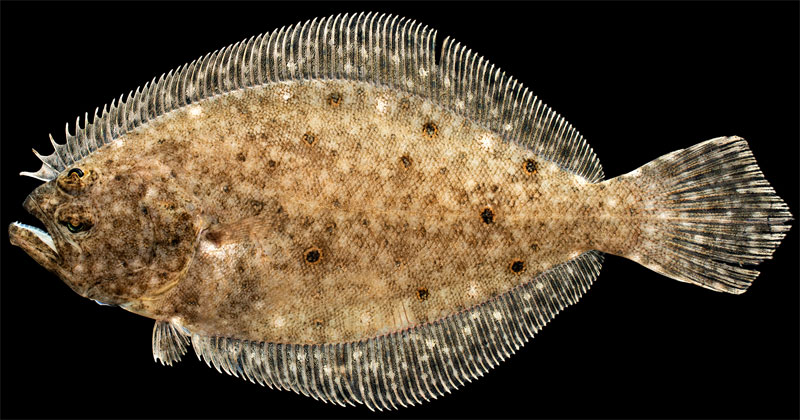
Download the mobile app!
Hooking Up Anglers Since 2011.
Check out our new Android or iOS app for Fishing Status.
The long awaited return of our mobie app is back on Apple App Store and Google Play
Flounder
Species Information
| Scientific Name: | Paralichthys dentatus |
| Common Names: | summer flounder, flounder, fluke |
| Environment: | Inshore, Nearshore, Surf |
| Ideal Temp: | 65-80°F (18-27°C) |
About Flounder
The Summer Flounder is a marine flatfish that is found in the Atlantic Ocean off the East coast of the United States and Canada. It is especially abundant in waters from North Carolina to Massachusetts.
Paralichthys dentatus (Linnaeus, 1766), also called a Fluke, is a member of the left-eyed flounder family Paralichthyidae. There are typically 5 to 14 ocellated (eye-like) spots on the body. Like most members of the left-eye flounders, they can change the color and pattern of their dark side to match the surrounding bottom, and are also capable of rapidly burrowing into muddy or sandy bottoms. The teeth are quite sharp and well developed on both upper and lower jaws. The average Summer flounder reaches sexual maturity at 2 years and weighs 1 to 3 pounds, typically 15 to 20 inches in length, though they may live up to 20 years with females making up the largest and oldest specimens. Adults are highly predatory and considered mostly piscivorous, often lying buried with only their head exposed to ambush prey which includes sand lance, menhaden, atlantic silverside, mummichog killifish, small bluefish, porgies, squid, shrimp, and crabs. While primarily considered a bottom fish, they are rapid swimmers over short distances and can become very aggressive, feeding actively at middepths, even chasing prey to the surface.
The Summer Flounder has a range in the western Atlantic from Nova Scotia to Florida, possibly further south where the Summer Flounder may mix and be confused with its close relative the Southern Flounder (Paralichthys lethostigma) which lacks the eye-like spots of the Summer flounder. Paralichthys dentatus is most common to the coastal and shelf waters off of the northeast U.S. where they are commonly called Fluke. In the spring months fluke leave their winter stay in the deep ocean waters, where spawning occurs, to move into the inshore waters along beaches, inlets, bays, estuaries, canals, and creeks where they will stay until autumn or even early winter.
It may be found in water as shallow as 6 in (15 cm) during the summer, though the largest specimens are found in depths of 8 to 10 fathoms. In the winter the large fish move offshore into depths of 25 to 80 fathoms.
Recreational fishing is typically done while drifting in a boat or casting from shore using a wide variety of methods which include live or cut baits on a bottom rig, artificial lures, or weighted jigs tipped with strip baits. Many are also taken by chumming while fishing at anchor, by trolling, or by casting from shore or pier. Effective baits include strips cut from shark, fluke menhaden, herring, porgy, young bluefish, or sea robin; or a piece of blue crab. Effective lures include a small spoon, spinner, or feather. Some time must be allowed between the moment the flounder picks up the bait and the strike, or the bail may simply be yanked away. Inshore fishing is best on a running tide, and the largest fish are caught late in the season. It is considered an excellent food fish with firm, mild tasting white meat.
Flounder Fishing
| World Record: | 10.17 kg (22 lb 7 oz) Montauk, New York , USA |
| # Fish Caught: | 1051209 documented in database. |
| Earliest Record: | 7/1/1819 12:00:00 AM and located at 40.66700, -73.83300. |
| Latest Record: | 4/5/2025 6:36:00 PM and located at 41.46440, -71.34150. |
| Common Techniques: | Bottom Fishing, Casting |
| Popular Lure Types: | Bottom Rig, Jigs, Spinnerbaits |
| Fishing Spots: | 40632 Flounder fishing spots. |
Latest Flounder Fishing Reports and Spots
Southern flounder shape the tempo of summer across South Carolina’s coastal creeks back bays and estuaries. These bottom-dwelling ambush feeders (
View)
We went out on May 24th like we do every day. This time in our morning trip the crowd was lighter so we decided to look for Fluke (summer flound (
View)
(
View)
(
View)
(
View)
(
View)
(
View)
(
View)
(
View)
(
View)